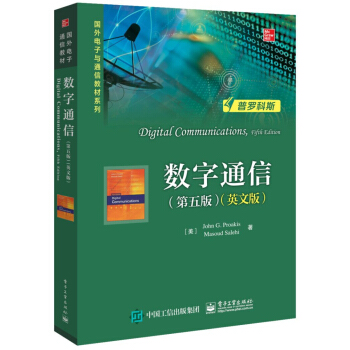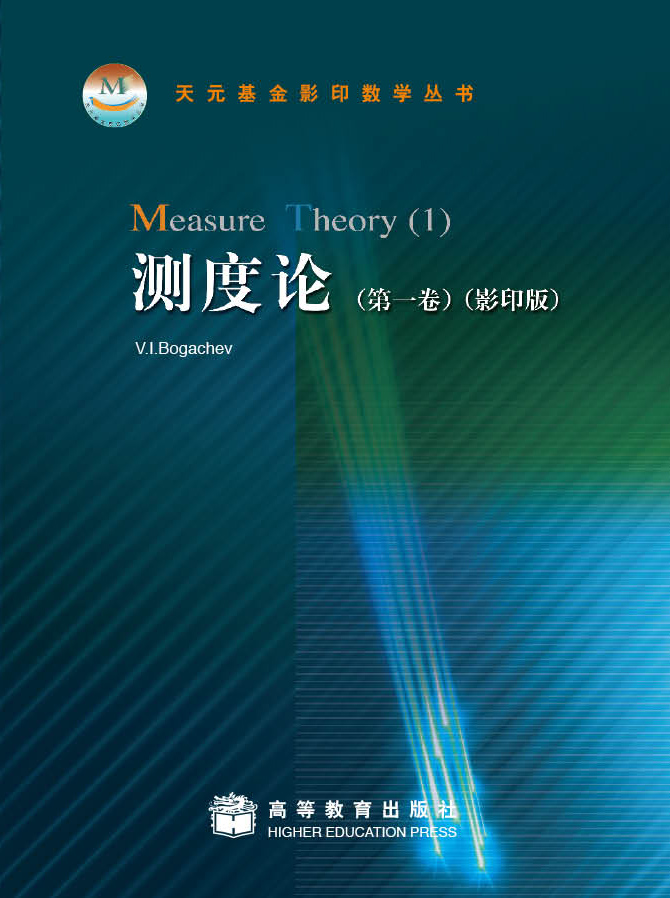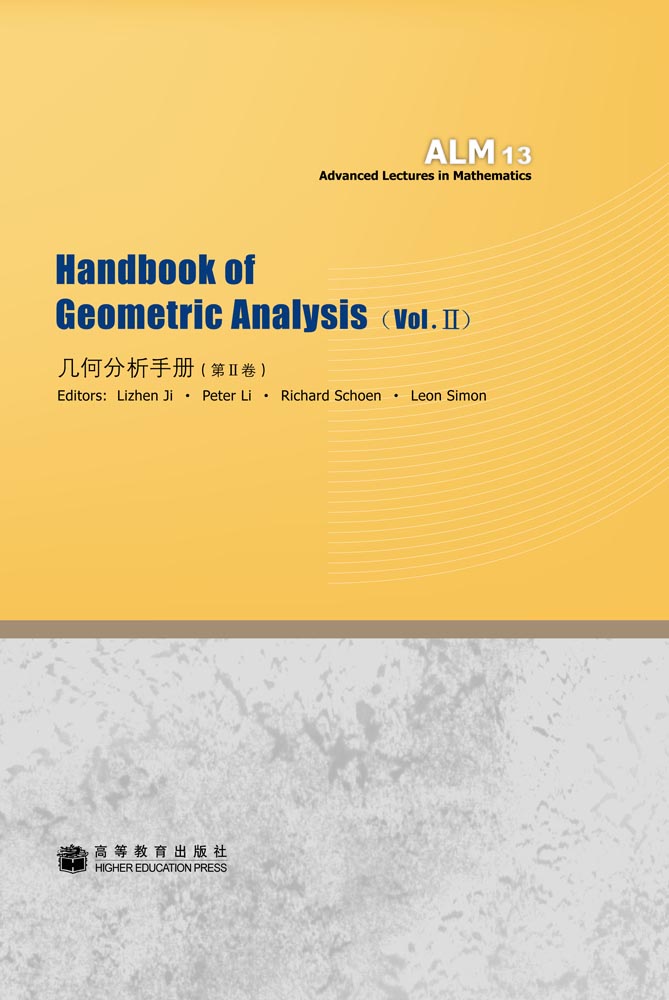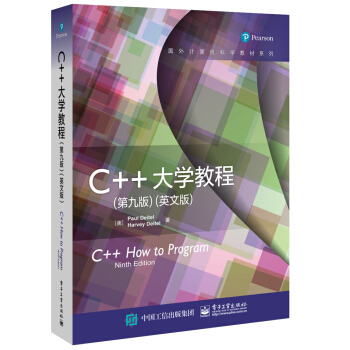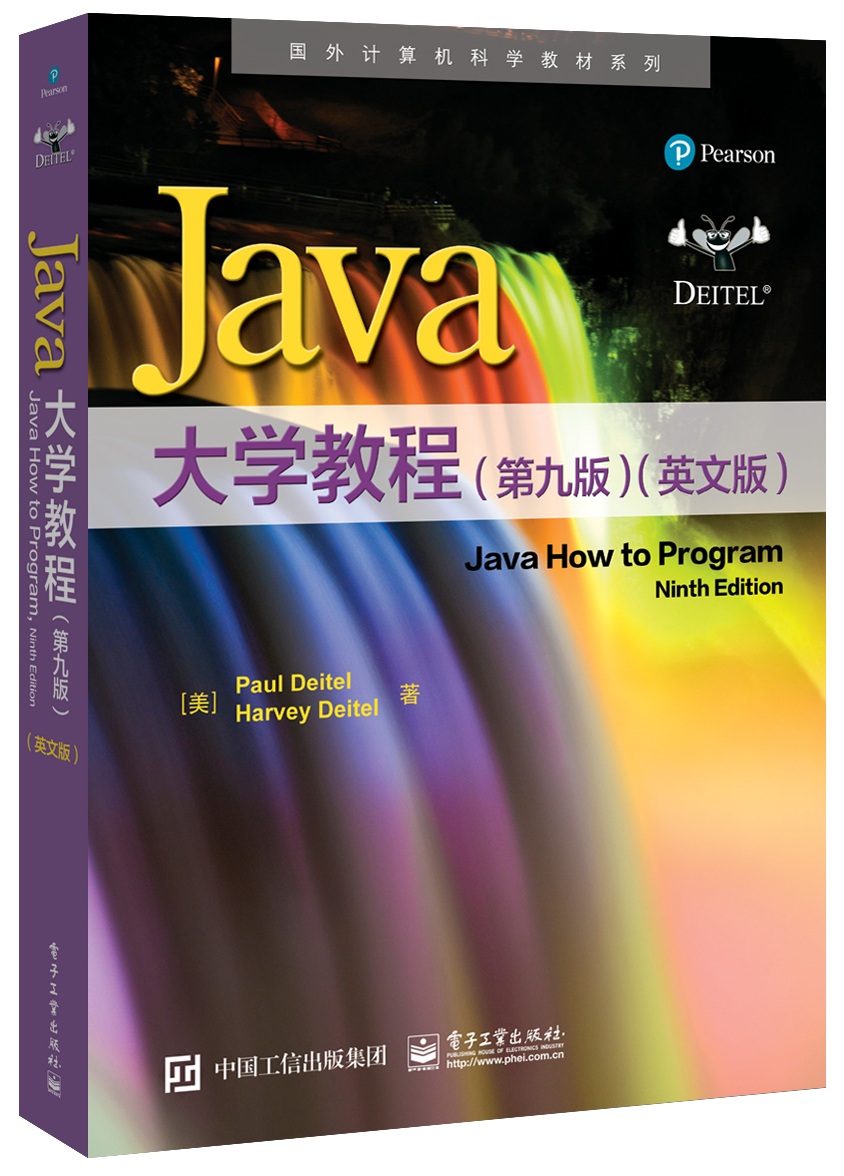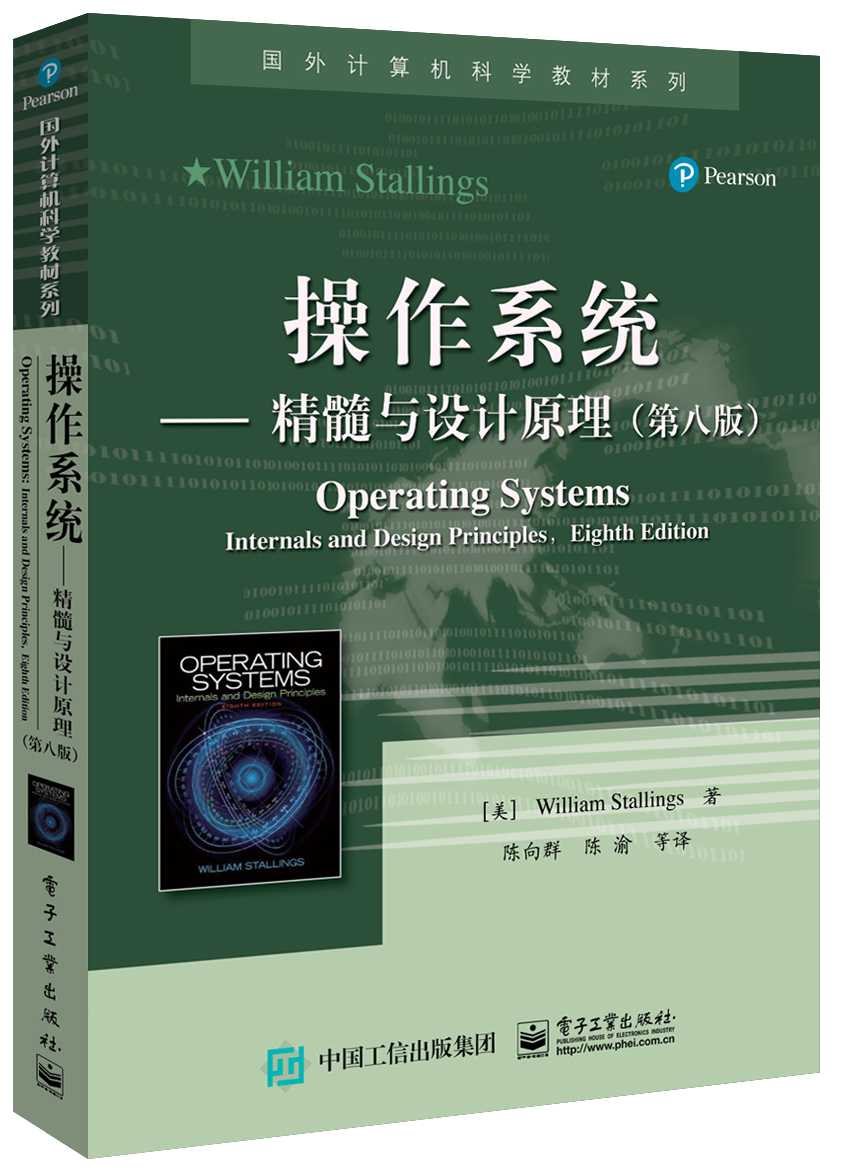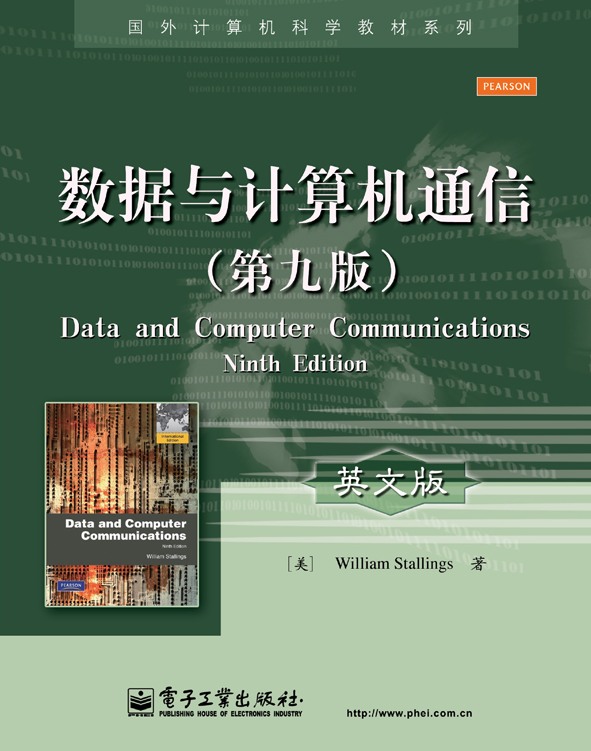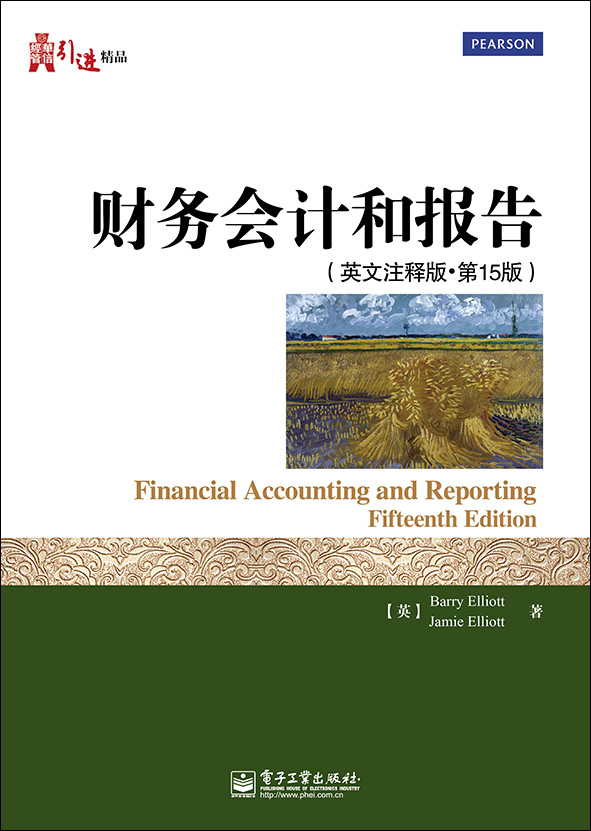数字通信(第五版)(英文版) / 国外电子与通信教材系列
¥199.00定价
作者: John G. Proakis(普罗科斯),Masoud Salehi(萨利希)
出版时间:2019-10
出版社:电子工业出版社
试读
- 电子工业出版社
- 9787121367519
- 1-1
- 295550
- 16开
- 2019-10
- 1168
- 通信工程
- 本科 研究生(硕士、EMBA、MBA、MPA、博士)
内容简介
本书是数字通信领域的一本优秀教材,既论述了数字通信的基本理论,又对数字通信的新技术进行了比较深入的分析。本书采用信号空间、随机过程的级数展开和等效低通等分析方法,根据最佳接收准则,先后讨论并分析了在加性高斯白噪声(AWGN)信道、带限信道(有符号间干扰和加性噪声)和多径衰落信道三种基本的典型信道条件下的数字信号可靠高效传输及最佳接收问题;从信号传输角度介绍了通信信号、数字调制、自适应均衡、多天线系统和最佳接收等内容;从信息传输角度介绍了信息论基础、信道容量和信道编码等内容。
目录
Preface
Chapter 1 Introduction 1
1.1 Elements of a Digital Communication System 1
1.2 Communication Channels and Their Characteristics 3
1.3 Mathematical Models for Communication Channels 10
1.4 A Historical Perspective in the Development of Digital Communications 12
1.5 Overview of the Book 15
1.6 Bibliographical Notes and References 15
Chapter 2 Deterministic and Random Signal Analysis 17
2.1 Bandpass and Lowpass Signal Representation 18
2.1–1 Bandpass and Lowpass Signals / 2.1–2 Lowpass Equivalent of Bandpass Signals / 2.1–3 Energy Considerations / 2.1–4 Lowpass Equivalent of a Bandpass System
2.2 Signal Space Representation of Waveforms 28
2.2–1 Vector Space Concepts / 2.2–2 Signal Space Concepts / 2.2–3 Orthogonal Expansions of Signals /2.2–4 Gram-Schmidt Procedure
2.3 Some Useful Random Variables 40
2.4 Bounds on Tail Probabilities 56
2.5 Limit Theorems for Sums of Random Variables 63
2.6 Complex Random Variables 63
2.6–1 Complex Random Vectors
2.7 Random Processes 66
2.7–1 Wide-Sense Stationary Random Processes / 2.7–2 Cyclostationary Random Processes / 2.7–3 Proper and Circular Random Processes / 2.7–4 Markov Chains
2.8 Series Expansion of Random Processes 74
2.8–1 Sampling Theorem for Band-Limited Random Processes / 2.8–2 The Karhunen-Loève Expansion
2.9 Bandpass and Lowpass Random Processes 78
2.10 Bibliographical Notes and References 82
Problems 82
Chapter 3 Digital Modulation Schemes 95
3.1 Representation of Digitally Modulated Signals 95
3.2 Memoryless Modulation Methods 97
3.2–1 Pulse Amplitude Modulation (PAM) / 3.2–2 Phase Modulation / 3.2–3 Quadrature Amplitude Modulation / 3.2–4 Multidimensional Signaling
3.3 Signaling Schemes with Memory 114
3.3–1 Continuous-Phase Frequency-Shift Keying (CPFSK) / 3.3–2 Continuous-Phase Modulation (CPM)
3.4 Power Spectrum of Digitally Modulated Signals 131
3.4–1 Power Spectral Density of a Digitally Modulated Signal with Memory / 3.4–2 Power Spectral Density of Linearly Modulated Signals / 3.4–3 Power Spectral Density of Digitally Modulated Signals with Finite Memory / 3.4–4 Power Spectral Density of Modulation Schemes with a Markov Structure / 3.4–5 Power Spectral Densities of CPFSK and CPM Signals
3.5 Bibliographical Notes and References 148
Problems 148
Chapter 4 Optimum Receivers for AWGN Channels 160
4.1 Waveform and Vector Channel Models 160
4.1–1 Optimal Detection for a General Vector Channel
4.2 Waveform and Vector AWGN Channels 167
4.2–1 Optimal Detection for the Vector AWGN Channel / 4.2–2 Implementation of the Optimal Receiver for AWGN Channels / 4.2–3 A Union Bound on the Probability of Error of Maximum Likelihood Detection
4.3 Optimal Detection and Error Probability for Band-Limited Signaling 188
4.3–1 Optimal Detection and Error Probability for ASK or PAM Signaling / 4.3–2 Optimal Detection and Error Probability for PSK Signaling / 4.3–3 Optimal Detection and Error Probability for QAM Signaling / 4.3–4 Demodulation and Detection
4.4 Optimal Detection and Error Probability for Power-Limited Signaling 203
4.4–1 Optimal Detection and Error Probability for Orthogonal Signaling / 4.4–2 Optimal Detection and Error Probability for Biorthogonal Signaling / 4.4–3 Optimal Detection and Error Probability for Simplex Signaling
4.5 Optimal Detection in Presence of Uncertainty: Noncoherent Detection 210
4.5–1 Noncoherent Detection of Carrier Modulated Signals / 4.5–2 Optimal Noncoherent Detection of FSK Modulated Signals / 4.5–3 Error Probability of Orthogonal Signaling with Noncoherent Detection / 4.5–4 Probability of Error for Envelope Detection of Correlated Binary Signals / 4.5–5 Differential PSK (DPSK)
4.6 A Comparison of Digital Signaling Methods 226
4.6–1 Bandwidth and Dimensionality
4.7 Lattices and Constellations Based on Lattices 230
4.7–1 An Introduction to Lattices / 4.7–2 Signal Constellations from Lattices
4.8 Detection of Signaling Schemes with Memory 242
4.8–1 The Maximum Likelihood Sequence Detector
4.9 Optimum Receiver for CPM Signals 246
4.9–1 Optimum Demodulation and Detection of CPM /4.9–2 Performance of CPM Signals / 4.9–3 Suboptimum Demodulation and Detection of CPM Signals
4.10 Performance Analysis for Wireline and Radio Communication Systems 259
4.10–1 Regenerative Repeaters / 4.10–2 Link Budget Analysis in Radio Communication Systems
4.11 Bibliographical Notes and References 265
Problems 266
Chapter 5 Carrier and Symbol Synchronization 290
5.1 Signal Parameter Estimation 290
5.1–1 The Likelihood Function / 5.1–2 Carrier Recovery and Symbol Synchronization in Signal Demodulation
5.2 Carrier Phase Estimation 295
5.2–1 Maximum-Likelihood Carrier Phase Estimation /5.2–2 The Phase-Locked Loop / 5.2–3 Effect of Additive Noise on the Phase Estimate / 5.2–4 Decision-Directed Loops / 5.2–5 Non-Decision-Directed Loops
5.3 Symbol Timing Estimation 315
5.3–1 Maximum-Likelihood Timing Estimation /5.3–2 Non-Decision-Directed Timing Estimation
5.4 Joint Estimation of Carrier Phase and Symbol Timing 321
5.5 Performance Characteristics of ML Estimators 323
5.6 Bibliographical Notes and References 326
Problems 327
Chapter 6 An Introduction to Information Theory 330
6.1 Mathematical Models for Information Sources 331
6.2 A Logarithmic Measure of Information 332
6.3 Lossless Coding of Information Sources 335
6.3–1 The Lossless Source Coding Theorem / 6.3–2 Lossless Coding Algorithms
6.4 Lossy Data Compression 348
6.4–1 Entropy and Mutual Information for Continuous Random Variables / 6.4–2 The Rate Distortion Function
6.5 Channel Models and Channel Capacity 354
6.5–1 Channel Models / 6.5–2 Channel Capacity
6.6 Achieving Channel Capacity with Orthogonal Signals 367
6.7 The Channel Reliability Function 369
6.8 The Channel Cutoff Rate 371
6.8–1 Bhattacharyya and Chernov Bounds / 6.8–2 Random Coding
6.9 Bibliographical Notes and References 380
Problems 381
Chapter 7 Linear Block Codes 400
7.1 Basic De?nitions 401
7.1–1 The Structure of Finite Fields / 7.1–2 Vector Spaces
7.2 General Properties of Linear Block Codes 411
7.2–1 Generator and Parity Check Matrices / 7.2–2 Weight and Distance for Linear Block Codes / 7.2–3 The Weight Distribution Polynomial / 7.2–4 Error Probability of Linear Block Codes
7.3 Some Speci?c Linear Block Codes 420
7.3–1 Repetition Codes / 7.3–2 Hamming Codes /7.3–3 Maximum-Length Codes / 7.3–4 Reed-Muller Codes / 7.3–5 Hadamard Codes / 7.3–6 Golay Codes
7.4 Optimum Soft Decision Decoding of Linear Block Codes 424
7.5 Hard Decision Decoding of Linear Block Codes 428
7.5–1 Error Detection and Error Correction Capability of Block Codes / 7.5–2 Block and Bit Error Probability for Hard Decision Decoding
7.6 Comparison of Performance between Hard Decision and Soft Decision Decoding 436
7.7 Bounds on Minimum Distance of Linear Block Codes 440
7.7–1 Singleton Bound / 7.7–2 Hamming Bound /7.7–3 Plotkin Bound / 7.7–4 Elias Bound / 7.7–5 McEliece-Rodemich-Rumsey-Welch (MRRW) Bound /7.7–6 Varshamov-Gilbert Bound
7.8 Modi?ed Linear Block Codes 445
7.8–1 Shortening and Lengthening / 7.8–2 Puncturing and Extending / 7.8–3 Expurgation and Augmentation
7.9 Cyclic Codes 447
7.9–1 Cyclic Codes — De?nition and Basic Properties /7.9–2 Systematic Cyclic Codes / 7.9–3 Encoders for Cyclic Codes / 7.9–4 Decoding Cyclic Codes / 7.9–5 Examples of Cyclic Codes
7.10 Bose-Chaudhuri-Hocquenghem (BCH) Codes 463
7.10–1 The Structure of BCH Codes / 7.10–2 Decoding BCH Codes
7.11 Reed-Solomon Codes 471
7.12 Coding for Channels with Burst Errors 475
7.13 Combining Codes 477
7.13–1 Product Codes / 7.13–2 Concatenated Codes
7.14 Bibliographical Notes and References 482
Problems 482
Chapter 8 Trellis and Graph Based Codes 491
8.1 The Structure of Convolutional Codes 491
8.1–1 Tree, Trellis, and State Diagrams / 8.1–2 The Transfer Function of a Convolutional Code / 8.1–3 Systematic, Nonrecursive, and Recursive Convolutional Codes /8.1–4 The Inverse of a Convolutional Encoder and Catastrophic Codes
8.2 Decoding of Convolutional Codes 510
8.2–1 Maximum-Likelihood Decoding of Convolutional Codes — The Viterbi Algorithm / 8.2–2 Probability of Error for Maximum-Likelihood Decoding of Convolutional Codes
8.3 Distance Properties of Binary Convolutional Codes 516
8.4 Punctured Convolutional Codes 516
8.4–1 Rate-Compatible Punctured Convolutional Codes
8.5 Other Decoding Algorithms for Convolutional Codes 525
8.6 Practical Considerations in the Application of Convolutional Codes 532
8.7 Nonbinary Dual-k Codes and Concatenated Codes 537
8.8 Maximum a Posteriori Decoding of Convolutional Codes — The BCJR Algorithm 541
8.9 Turbo Codes and Iterative Decoding 548
8.9–1 Performance Bounds for Turbo Codes / 8.9–2 Iterative Decoding for Turbo Codes / 8.9–3 EXIT Chart Study of Iterative Decoding
8.10 Factor Graphs and the Sum-Product Algorithm 558
8.10–1 Tanner Graphs / 8.10–2 Factor Graphs / 8.10–3 The Sum-Product Algorithm / 8.10–4 MAP Decoding Using the Sum-Product Algorithm
8.11 Low Density Parity Check Codes 568
8.11–1 Decoding LDPC Codes
8.12 Coding for Bandwidth-Constrained Channels — Trellis Coded Modulation 571
8.12–1 Lattices and Trellis Coded Modulation /8.12–2 Turbo-Coded Bandwidth Ef?cient Modulation
8.13 Bibliographical Notes and References 589
Problems 590
Chapter 9 Digital Communication Through Band-Limited Channels 597
9.1 Characterization of Band-Limited Channels 598
9.2 Signal Design for Band-Limited Channels 602
9.2–1 Design of Band-Limited Signals for No Intersymbol Interference—The Nyquist Criterion / 9.2–2 Design of Band-Limited Signals with Controlled ISI—Partial-Response Signals / 9.2–3 Data Detection for Controlled ISI /9.2–4 Signal Design for Channels with Distortion
9.3 Optimum Receiver for Channels with ISI and AWGN 623
9.3–1 Optimum Maximum-Likelihood Receiver /9.3–2 A Discrete-Time Model for a Channel with ISI /9.3–3 Maximum-Likelihood Sequence Estimation (MLSE) for the Discrete-Time White Noise Filter Model /9.3–4 Performance of MLSE for Channels with ISI
9.4 Linear Equalization 640
9.4–1 Peak Distortion Criterion / 9.4–2 Mean-Square-Error (MSE) Criterion / 9.4–3 Performance Characteristics of the MSE Equalizer / 9.4–4 Fractionally Spaced Equalizers / 9.4–5 Baseband and Passband Linear Equalizers
9.5 Decision-Feedback Equalization 661
9.5–1 Coef?cient Optimization / 9.5–2 Performance Characteristics of DFE / 9.5–3 Predictive Decision-Feedback Equalizer / 9.5–4 Equalization at the Transmitter—Tomlinson–Harashima Precoding
9.6 Reduced Complexity ML Detectors 669
9.7 Iterative Equalization and Decoding—Turbo Equalization 671
9.8 Bibliographical Notes and References 673
Problems 674
Chapter 10 Adaptive Equalization 689
10.1 Adaptive Linear Equalizer 689
10.1–1 The Zero-Forcing Algorithm / 10.1–2 The LMS Algorithm / 10.1–3 Convergence Properties of the LMS Algorithm / 10.1–4 Excess MSE due to Noisy Gradient Estimates / 10.1–5 Accelerating the Initial Convergence Rate in the LMS Algorithm / 10.1–6 Adaptive Fractionally Spaced Equalizer—The Tap Leakage Algorithm / 10.1–7 An Adaptive Channel Estimator for ML Sequence Detection
10.2 Adaptive Decision-Feedback Equalizer 705
10.3 Adaptive Equalization of Trellis-Coded Signals 706
10.4 Recursive Least-Squares Algorithms for Adaptive Equalization 710
10.4–1 Recursive Least-Squares (Kalman) Algorithm / 10.4–2 Linear Prediction and the Lattice Filter
10.5 Self-Recovering (Blind) Equalization 721
10.5–1 Blind Equalization Based on the Maximum-Likelihood Criterion / 10.5–2 Stochastic Gradient Algorithms /10.5–3 Blind Equalization Algorithms Based on Second- and Higher-Order Signal Statistics
10.6 Bibliographical Notes and References 731
Problems 732
Chapter 11 Multichannel and Multicarrier Systems 737
11.1 Multichannel Digital Communications in AWGN Channels 737
11.1–1 Binary Signals / 11.1–2 M-ary Orthogonal Signals
11.2 Multicarrier Communications 743
11.2–1 Single-Carrier Versus Multicarrier Modulation / 11.2–2 Capacity of a Nonideal Linear Filter Channel / 11.2–3 Orthogonal Frequency Division Multiplexing (OFDM) / 11.2–4 Modulation and Demodulation in an OFDM System / 11.2–5 An FFT Algorithm Implementation of an OFDM System / 11.2–6 Spectral Characteristics of Multicarrier Signals / 11.2–7 Bit and Power Allocation in Multicarrier Modulation / 11.2–8 Peak-to-Average Ratio in Multicarrier Modulation / 11.2–9 Channel Coding Considerations in Multicarrier Modulation
11.3 Bibliographical Notes and References 759 Problems 760
Chapter 12 Spread Spectrum Signals for Digital Communications 762
12.1 Model of Spread Spectrum Digital Communication System 763
12.2 Direct Sequence Spread Spectrum Signals 765
12.2–1 Error Rate Performance of the Decoder /12.2–2 Some Applications of DS Spread Spectrum Signals / 12.2–3 Effect of Pulsed Interference on DS Spread Spectrum Systems / 12.2–4 Excision of Narrowband Interference in DS Spread Spectrum Systems /12.2–5 Generation of PN Sequences
12.3 Frequency-Hopped Spread Spectrum Signals 802
12.3–1 Performance of FH Spread Spectrum Signals in an AWGN Channel / 12.3–2 Performance of FH Spread Spectrum Signals in Partial-Band Interference / 12.3–3 A CDMA System Based on FH Spread Spectrum Signals
12.4 Other Types of Spread Spectrum Signals 814
12.5 Synchronization of Spread Spectrum Systems 815
12.6 Bibliographical Notes and References 823
Problems 823
Chapter 13 Fading Channels I: Characterization and Signaling 830
13.1 Characterization of Fading Multipath Channels 831
13.1–1 Channel Correlation Functions and Power Spectra / 13.1–2 Statistical Models for Fading Channels
13.2 The Effect of Signal Characteristics on the Choice of a Channel Model 844
13.3 Frequency-Nonselective, Slowly Fading Channel 846
13.4 Diversity Techniques for Fading Multipath Channels 850
13.4–1 Binary Signals / 13.4–2 Multiphase Signals / 13.4–3 M-ary Orthogonal Signals
13.5 Signaling over a Frequency-Selective, Slowly Fading Channel: The RAKE Demodulator 869
13.5–1 A Tapped-Delay-Line Channel Model / 13.5–2 The RAKE Demodulator / 13.5–3 Performance of RAKE Demodulator / 13.5–4 Receiver Structures for Channels with Intersymbol Interference
13.6 Multicarrier Modulation (OFDM) 884
13.6–1 Performance Degradation of an OFDM System due to Doppler Spreading / 13.6–2 Suppression of ICI in OFDM Systems
13.7 Bibliographical Notes and References 890
Problems 891
Chapter 14 Fading Channels II: Capacity and Coding 899
14.1 Capacity of Fading Channels 900
14.1–1 Capacity of Finite-State Channels
14.2 Ergodic and Outage Capacity 905
14.2–1 The Ergodic Capacity of the Rayleigh Fading Channel / 14.2–2 The Outage Capacity of Rayleigh Fading Channels
14.3 Coding for Fading Channels 918
14.4 Performance of Coded Systems In Fading Channels 919
14.4–1 Coding for Fully Interleaved Channel Model
14.5 Trellis-Coded Modulation for Fading Channels 929
14.5–1 TCM Systems for Fading Channels / 14.5–2 Multiple Trellis-Coded Modulation (MTCM)
14.6 Bit-Interleaved Coded Modulation 936
14.7 Coding in the Frequency Domain 942
14.7–1 Probability of Error for Soft Decision Decoding of Linear Binary Block Codes / 14.7–2 Probability of Error for Hard-Decision Decoding of Linear Block Codes / 14.7–3 Upper Bounds on the Performance of Convolutional Codes for a Rayleigh Fading Channel / 14.7–4 Use of Constant-Weight Codes and Concatenated Codes for a Fading Channel
14.8 The Channel Cutoff Rate for Fading Channels 957
14.8–1 Channel Cutoff Rate for Fully Interleaved Fading Channels with CSI at Receiver
14.9 Bibliographical Notes and References 960
Problems 961
Chapter 15 Multiple-Antenna Systems 966
15.1 Channel Models for Multiple-Antenna Systems 966
15.1–1 Signal Transmission Through a Slow Fading Frequency-Nonselective MIMO Channel / 15.1–2 Detection of Data Symbols in a MIMO System / 15.1–3 Signal Transmission Through a Slow Fading Frequency-Selective MIMO Channel
15.2 Capacity of MIMO Channels 981
15.2–1 Mathematical Preliminaries / 15.2–2 Capacity of a Frequency-Nonselective Deterministic MIMO Channel / 15.2–3 Capacity of a Frequency-Nonselective Ergodic Random MIMO Channel / 15.2–4 Outage Capacity / 15.2–5 Capacity of MIMO Channel When the Channel Is Known at the Transmitter
15.3 Spread Spectrum Signals and Multicode Transmission 992
15.3–1 Orthogonal Spreading Sequences / 15.3–2 Multiplexing Gain Versus Diversity Gain / 15.3–3 Multicode MIMO Systems
15.4 Coding for MIMO Channels 1001
15.4–1 Performance of Temporally Coded SISO Systems in Rayleigh Fading Channels / 15.4–2 Bit-Interleaved Temporal Coding for MIMO Channels / 15.4–3 Space-Time Block Codes for MIMO Channels / 15.4–4 Pairwise Error Probability for a Space-Time Code / 15.4–5 Space-Time Trellis Codes for MIMO Channels / 15.4–6 Concatenated Space-Time Codes and Turbo Codes
15.5 Bibliographical Notes and References 1021
Problems 1021
Chapter 16 Multiuser Communications 1028
16.1 Introduction to Multiple Access Techniques 1028
16.2 Capacity of Multiple Access Methods 1031
16.3 Multiuser Detection in CDMA Systems 1036
16.3–1 CDMA Signal and Channel Models / 16.3–2 The Optimum Multiuser Receiver / 16.3–3 Suboptimum Detectors / 16.3–4 Successive Interference Cancellation / 16.3–5 Other Types of Multiuser Detectors / 16.3–6 Performance Characteristics of Detectors
16.4 Multiuser MIMO Systems for Broadcast Channels 1053
16.4–1 Linear Precoding of the Transmitted Signals / 16.4–2 Nonlinear Precoding of the Transmitted Signals—The QR Decomposition / 16.4–3 Nonlinear Vector Precoding / 16.4–4 Lattice Reduction Technique for Precoding
16.5 Random Access Methods 1068
16.5–1 ALOHA Systems and Protocols / 16.5–2 Carrier Sense Systems and Protocols
16.6 Bibliographical Notes and References 1077
Problems 1078
Appendix A Matrices 1085
A.1 Eigenvalues and Eigenvectors of a Matrix 1086
A.2 Singular-Value Decomposition 1087
A.3 Matrix Norm and Condition Number 1088
A.4 The Moore–Penrose Pseudoinverse 1088
Appendix B Error Probability for Multichannel Binary Signals 1090
Appendix C Error Probabilities for Adaptive Reception of M-Phase Signals 1096
C.1 Mathematical Model for an M-Phase Signaling Communication System 1096
C.2 Characteristic Function and Probability Density Function of the Phase θ 1098
C.3 Error Probabilities for Slowly Fading Rayleigh Channels 1100
C.4 Error Probabilities for Time-Invariant and Ricean Fading Channels 1104
Appendix D Square Root Factorization 1107
References and Bibliography 1109
Index 1142
Chapter 1 Introduction 1
1.1 Elements of a Digital Communication System 1
1.2 Communication Channels and Their Characteristics 3
1.3 Mathematical Models for Communication Channels 10
1.4 A Historical Perspective in the Development of Digital Communications 12
1.5 Overview of the Book 15
1.6 Bibliographical Notes and References 15
Chapter 2 Deterministic and Random Signal Analysis 17
2.1 Bandpass and Lowpass Signal Representation 18
2.1–1 Bandpass and Lowpass Signals / 2.1–2 Lowpass Equivalent of Bandpass Signals / 2.1–3 Energy Considerations / 2.1–4 Lowpass Equivalent of a Bandpass System
2.2 Signal Space Representation of Waveforms 28
2.2–1 Vector Space Concepts / 2.2–2 Signal Space Concepts / 2.2–3 Orthogonal Expansions of Signals /2.2–4 Gram-Schmidt Procedure
2.3 Some Useful Random Variables 40
2.4 Bounds on Tail Probabilities 56
2.5 Limit Theorems for Sums of Random Variables 63
2.6 Complex Random Variables 63
2.6–1 Complex Random Vectors
2.7 Random Processes 66
2.7–1 Wide-Sense Stationary Random Processes / 2.7–2 Cyclostationary Random Processes / 2.7–3 Proper and Circular Random Processes / 2.7–4 Markov Chains
2.8 Series Expansion of Random Processes 74
2.8–1 Sampling Theorem for Band-Limited Random Processes / 2.8–2 The Karhunen-Loève Expansion
2.9 Bandpass and Lowpass Random Processes 78
2.10 Bibliographical Notes and References 82
Problems 82
Chapter 3 Digital Modulation Schemes 95
3.1 Representation of Digitally Modulated Signals 95
3.2 Memoryless Modulation Methods 97
3.2–1 Pulse Amplitude Modulation (PAM) / 3.2–2 Phase Modulation / 3.2–3 Quadrature Amplitude Modulation / 3.2–4 Multidimensional Signaling
3.3 Signaling Schemes with Memory 114
3.3–1 Continuous-Phase Frequency-Shift Keying (CPFSK) / 3.3–2 Continuous-Phase Modulation (CPM)
3.4 Power Spectrum of Digitally Modulated Signals 131
3.4–1 Power Spectral Density of a Digitally Modulated Signal with Memory / 3.4–2 Power Spectral Density of Linearly Modulated Signals / 3.4–3 Power Spectral Density of Digitally Modulated Signals with Finite Memory / 3.4–4 Power Spectral Density of Modulation Schemes with a Markov Structure / 3.4–5 Power Spectral Densities of CPFSK and CPM Signals
3.5 Bibliographical Notes and References 148
Problems 148
Chapter 4 Optimum Receivers for AWGN Channels 160
4.1 Waveform and Vector Channel Models 160
4.1–1 Optimal Detection for a General Vector Channel
4.2 Waveform and Vector AWGN Channels 167
4.2–1 Optimal Detection for the Vector AWGN Channel / 4.2–2 Implementation of the Optimal Receiver for AWGN Channels / 4.2–3 A Union Bound on the Probability of Error of Maximum Likelihood Detection
4.3 Optimal Detection and Error Probability for Band-Limited Signaling 188
4.3–1 Optimal Detection and Error Probability for ASK or PAM Signaling / 4.3–2 Optimal Detection and Error Probability for PSK Signaling / 4.3–3 Optimal Detection and Error Probability for QAM Signaling / 4.3–4 Demodulation and Detection
4.4 Optimal Detection and Error Probability for Power-Limited Signaling 203
4.4–1 Optimal Detection and Error Probability for Orthogonal Signaling / 4.4–2 Optimal Detection and Error Probability for Biorthogonal Signaling / 4.4–3 Optimal Detection and Error Probability for Simplex Signaling
4.5 Optimal Detection in Presence of Uncertainty: Noncoherent Detection 210
4.5–1 Noncoherent Detection of Carrier Modulated Signals / 4.5–2 Optimal Noncoherent Detection of FSK Modulated Signals / 4.5–3 Error Probability of Orthogonal Signaling with Noncoherent Detection / 4.5–4 Probability of Error for Envelope Detection of Correlated Binary Signals / 4.5–5 Differential PSK (DPSK)
4.6 A Comparison of Digital Signaling Methods 226
4.6–1 Bandwidth and Dimensionality
4.7 Lattices and Constellations Based on Lattices 230
4.7–1 An Introduction to Lattices / 4.7–2 Signal Constellations from Lattices
4.8 Detection of Signaling Schemes with Memory 242
4.8–1 The Maximum Likelihood Sequence Detector
4.9 Optimum Receiver for CPM Signals 246
4.9–1 Optimum Demodulation and Detection of CPM /4.9–2 Performance of CPM Signals / 4.9–3 Suboptimum Demodulation and Detection of CPM Signals
4.10 Performance Analysis for Wireline and Radio Communication Systems 259
4.10–1 Regenerative Repeaters / 4.10–2 Link Budget Analysis in Radio Communication Systems
4.11 Bibliographical Notes and References 265
Problems 266
Chapter 5 Carrier and Symbol Synchronization 290
5.1 Signal Parameter Estimation 290
5.1–1 The Likelihood Function / 5.1–2 Carrier Recovery and Symbol Synchronization in Signal Demodulation
5.2 Carrier Phase Estimation 295
5.2–1 Maximum-Likelihood Carrier Phase Estimation /5.2–2 The Phase-Locked Loop / 5.2–3 Effect of Additive Noise on the Phase Estimate / 5.2–4 Decision-Directed Loops / 5.2–5 Non-Decision-Directed Loops
5.3 Symbol Timing Estimation 315
5.3–1 Maximum-Likelihood Timing Estimation /5.3–2 Non-Decision-Directed Timing Estimation
5.4 Joint Estimation of Carrier Phase and Symbol Timing 321
5.5 Performance Characteristics of ML Estimators 323
5.6 Bibliographical Notes and References 326
Problems 327
Chapter 6 An Introduction to Information Theory 330
6.1 Mathematical Models for Information Sources 331
6.2 A Logarithmic Measure of Information 332
6.3 Lossless Coding of Information Sources 335
6.3–1 The Lossless Source Coding Theorem / 6.3–2 Lossless Coding Algorithms
6.4 Lossy Data Compression 348
6.4–1 Entropy and Mutual Information for Continuous Random Variables / 6.4–2 The Rate Distortion Function
6.5 Channel Models and Channel Capacity 354
6.5–1 Channel Models / 6.5–2 Channel Capacity
6.6 Achieving Channel Capacity with Orthogonal Signals 367
6.7 The Channel Reliability Function 369
6.8 The Channel Cutoff Rate 371
6.8–1 Bhattacharyya and Chernov Bounds / 6.8–2 Random Coding
6.9 Bibliographical Notes and References 380
Problems 381
Chapter 7 Linear Block Codes 400
7.1 Basic De?nitions 401
7.1–1 The Structure of Finite Fields / 7.1–2 Vector Spaces
7.2 General Properties of Linear Block Codes 411
7.2–1 Generator and Parity Check Matrices / 7.2–2 Weight and Distance for Linear Block Codes / 7.2–3 The Weight Distribution Polynomial / 7.2–4 Error Probability of Linear Block Codes
7.3 Some Speci?c Linear Block Codes 420
7.3–1 Repetition Codes / 7.3–2 Hamming Codes /7.3–3 Maximum-Length Codes / 7.3–4 Reed-Muller Codes / 7.3–5 Hadamard Codes / 7.3–6 Golay Codes
7.4 Optimum Soft Decision Decoding of Linear Block Codes 424
7.5 Hard Decision Decoding of Linear Block Codes 428
7.5–1 Error Detection and Error Correction Capability of Block Codes / 7.5–2 Block and Bit Error Probability for Hard Decision Decoding
7.6 Comparison of Performance between Hard Decision and Soft Decision Decoding 436
7.7 Bounds on Minimum Distance of Linear Block Codes 440
7.7–1 Singleton Bound / 7.7–2 Hamming Bound /7.7–3 Plotkin Bound / 7.7–4 Elias Bound / 7.7–5 McEliece-Rodemich-Rumsey-Welch (MRRW) Bound /7.7–6 Varshamov-Gilbert Bound
7.8 Modi?ed Linear Block Codes 445
7.8–1 Shortening and Lengthening / 7.8–2 Puncturing and Extending / 7.8–3 Expurgation and Augmentation
7.9 Cyclic Codes 447
7.9–1 Cyclic Codes — De?nition and Basic Properties /7.9–2 Systematic Cyclic Codes / 7.9–3 Encoders for Cyclic Codes / 7.9–4 Decoding Cyclic Codes / 7.9–5 Examples of Cyclic Codes
7.10 Bose-Chaudhuri-Hocquenghem (BCH) Codes 463
7.10–1 The Structure of BCH Codes / 7.10–2 Decoding BCH Codes
7.11 Reed-Solomon Codes 471
7.12 Coding for Channels with Burst Errors 475
7.13 Combining Codes 477
7.13–1 Product Codes / 7.13–2 Concatenated Codes
7.14 Bibliographical Notes and References 482
Problems 482
Chapter 8 Trellis and Graph Based Codes 491
8.1 The Structure of Convolutional Codes 491
8.1–1 Tree, Trellis, and State Diagrams / 8.1–2 The Transfer Function of a Convolutional Code / 8.1–3 Systematic, Nonrecursive, and Recursive Convolutional Codes /8.1–4 The Inverse of a Convolutional Encoder and Catastrophic Codes
8.2 Decoding of Convolutional Codes 510
8.2–1 Maximum-Likelihood Decoding of Convolutional Codes — The Viterbi Algorithm / 8.2–2 Probability of Error for Maximum-Likelihood Decoding of Convolutional Codes
8.3 Distance Properties of Binary Convolutional Codes 516
8.4 Punctured Convolutional Codes 516
8.4–1 Rate-Compatible Punctured Convolutional Codes
8.5 Other Decoding Algorithms for Convolutional Codes 525
8.6 Practical Considerations in the Application of Convolutional Codes 532
8.7 Nonbinary Dual-k Codes and Concatenated Codes 537
8.8 Maximum a Posteriori Decoding of Convolutional Codes — The BCJR Algorithm 541
8.9 Turbo Codes and Iterative Decoding 548
8.9–1 Performance Bounds for Turbo Codes / 8.9–2 Iterative Decoding for Turbo Codes / 8.9–3 EXIT Chart Study of Iterative Decoding
8.10 Factor Graphs and the Sum-Product Algorithm 558
8.10–1 Tanner Graphs / 8.10–2 Factor Graphs / 8.10–3 The Sum-Product Algorithm / 8.10–4 MAP Decoding Using the Sum-Product Algorithm
8.11 Low Density Parity Check Codes 568
8.11–1 Decoding LDPC Codes
8.12 Coding for Bandwidth-Constrained Channels — Trellis Coded Modulation 571
8.12–1 Lattices and Trellis Coded Modulation /8.12–2 Turbo-Coded Bandwidth Ef?cient Modulation
8.13 Bibliographical Notes and References 589
Problems 590
Chapter 9 Digital Communication Through Band-Limited Channels 597
9.1 Characterization of Band-Limited Channels 598
9.2 Signal Design for Band-Limited Channels 602
9.2–1 Design of Band-Limited Signals for No Intersymbol Interference—The Nyquist Criterion / 9.2–2 Design of Band-Limited Signals with Controlled ISI—Partial-Response Signals / 9.2–3 Data Detection for Controlled ISI /9.2–4 Signal Design for Channels with Distortion
9.3 Optimum Receiver for Channels with ISI and AWGN 623
9.3–1 Optimum Maximum-Likelihood Receiver /9.3–2 A Discrete-Time Model for a Channel with ISI /9.3–3 Maximum-Likelihood Sequence Estimation (MLSE) for the Discrete-Time White Noise Filter Model /9.3–4 Performance of MLSE for Channels with ISI
9.4 Linear Equalization 640
9.4–1 Peak Distortion Criterion / 9.4–2 Mean-Square-Error (MSE) Criterion / 9.4–3 Performance Characteristics of the MSE Equalizer / 9.4–4 Fractionally Spaced Equalizers / 9.4–5 Baseband and Passband Linear Equalizers
9.5 Decision-Feedback Equalization 661
9.5–1 Coef?cient Optimization / 9.5–2 Performance Characteristics of DFE / 9.5–3 Predictive Decision-Feedback Equalizer / 9.5–4 Equalization at the Transmitter—Tomlinson–Harashima Precoding
9.6 Reduced Complexity ML Detectors 669
9.7 Iterative Equalization and Decoding—Turbo Equalization 671
9.8 Bibliographical Notes and References 673
Problems 674
Chapter 10 Adaptive Equalization 689
10.1 Adaptive Linear Equalizer 689
10.1–1 The Zero-Forcing Algorithm / 10.1–2 The LMS Algorithm / 10.1–3 Convergence Properties of the LMS Algorithm / 10.1–4 Excess MSE due to Noisy Gradient Estimates / 10.1–5 Accelerating the Initial Convergence Rate in the LMS Algorithm / 10.1–6 Adaptive Fractionally Spaced Equalizer—The Tap Leakage Algorithm / 10.1–7 An Adaptive Channel Estimator for ML Sequence Detection
10.2 Adaptive Decision-Feedback Equalizer 705
10.3 Adaptive Equalization of Trellis-Coded Signals 706
10.4 Recursive Least-Squares Algorithms for Adaptive Equalization 710
10.4–1 Recursive Least-Squares (Kalman) Algorithm / 10.4–2 Linear Prediction and the Lattice Filter
10.5 Self-Recovering (Blind) Equalization 721
10.5–1 Blind Equalization Based on the Maximum-Likelihood Criterion / 10.5–2 Stochastic Gradient Algorithms /10.5–3 Blind Equalization Algorithms Based on Second- and Higher-Order Signal Statistics
10.6 Bibliographical Notes and References 731
Problems 732
Chapter 11 Multichannel and Multicarrier Systems 737
11.1 Multichannel Digital Communications in AWGN Channels 737
11.1–1 Binary Signals / 11.1–2 M-ary Orthogonal Signals
11.2 Multicarrier Communications 743
11.2–1 Single-Carrier Versus Multicarrier Modulation / 11.2–2 Capacity of a Nonideal Linear Filter Channel / 11.2–3 Orthogonal Frequency Division Multiplexing (OFDM) / 11.2–4 Modulation and Demodulation in an OFDM System / 11.2–5 An FFT Algorithm Implementation of an OFDM System / 11.2–6 Spectral Characteristics of Multicarrier Signals / 11.2–7 Bit and Power Allocation in Multicarrier Modulation / 11.2–8 Peak-to-Average Ratio in Multicarrier Modulation / 11.2–9 Channel Coding Considerations in Multicarrier Modulation
11.3 Bibliographical Notes and References 759 Problems 760
Chapter 12 Spread Spectrum Signals for Digital Communications 762
12.1 Model of Spread Spectrum Digital Communication System 763
12.2 Direct Sequence Spread Spectrum Signals 765
12.2–1 Error Rate Performance of the Decoder /12.2–2 Some Applications of DS Spread Spectrum Signals / 12.2–3 Effect of Pulsed Interference on DS Spread Spectrum Systems / 12.2–4 Excision of Narrowband Interference in DS Spread Spectrum Systems /12.2–5 Generation of PN Sequences
12.3 Frequency-Hopped Spread Spectrum Signals 802
12.3–1 Performance of FH Spread Spectrum Signals in an AWGN Channel / 12.3–2 Performance of FH Spread Spectrum Signals in Partial-Band Interference / 12.3–3 A CDMA System Based on FH Spread Spectrum Signals
12.4 Other Types of Spread Spectrum Signals 814
12.5 Synchronization of Spread Spectrum Systems 815
12.6 Bibliographical Notes and References 823
Problems 823
Chapter 13 Fading Channels I: Characterization and Signaling 830
13.1 Characterization of Fading Multipath Channels 831
13.1–1 Channel Correlation Functions and Power Spectra / 13.1–2 Statistical Models for Fading Channels
13.2 The Effect of Signal Characteristics on the Choice of a Channel Model 844
13.3 Frequency-Nonselective, Slowly Fading Channel 846
13.4 Diversity Techniques for Fading Multipath Channels 850
13.4–1 Binary Signals / 13.4–2 Multiphase Signals / 13.4–3 M-ary Orthogonal Signals
13.5 Signaling over a Frequency-Selective, Slowly Fading Channel: The RAKE Demodulator 869
13.5–1 A Tapped-Delay-Line Channel Model / 13.5–2 The RAKE Demodulator / 13.5–3 Performance of RAKE Demodulator / 13.5–4 Receiver Structures for Channels with Intersymbol Interference
13.6 Multicarrier Modulation (OFDM) 884
13.6–1 Performance Degradation of an OFDM System due to Doppler Spreading / 13.6–2 Suppression of ICI in OFDM Systems
13.7 Bibliographical Notes and References 890
Problems 891
Chapter 14 Fading Channels II: Capacity and Coding 899
14.1 Capacity of Fading Channels 900
14.1–1 Capacity of Finite-State Channels
14.2 Ergodic and Outage Capacity 905
14.2–1 The Ergodic Capacity of the Rayleigh Fading Channel / 14.2–2 The Outage Capacity of Rayleigh Fading Channels
14.3 Coding for Fading Channels 918
14.4 Performance of Coded Systems In Fading Channels 919
14.4–1 Coding for Fully Interleaved Channel Model
14.5 Trellis-Coded Modulation for Fading Channels 929
14.5–1 TCM Systems for Fading Channels / 14.5–2 Multiple Trellis-Coded Modulation (MTCM)
14.6 Bit-Interleaved Coded Modulation 936
14.7 Coding in the Frequency Domain 942
14.7–1 Probability of Error for Soft Decision Decoding of Linear Binary Block Codes / 14.7–2 Probability of Error for Hard-Decision Decoding of Linear Block Codes / 14.7–3 Upper Bounds on the Performance of Convolutional Codes for a Rayleigh Fading Channel / 14.7–4 Use of Constant-Weight Codes and Concatenated Codes for a Fading Channel
14.8 The Channel Cutoff Rate for Fading Channels 957
14.8–1 Channel Cutoff Rate for Fully Interleaved Fading Channels with CSI at Receiver
14.9 Bibliographical Notes and References 960
Problems 961
Chapter 15 Multiple-Antenna Systems 966
15.1 Channel Models for Multiple-Antenna Systems 966
15.1–1 Signal Transmission Through a Slow Fading Frequency-Nonselective MIMO Channel / 15.1–2 Detection of Data Symbols in a MIMO System / 15.1–3 Signal Transmission Through a Slow Fading Frequency-Selective MIMO Channel
15.2 Capacity of MIMO Channels 981
15.2–1 Mathematical Preliminaries / 15.2–2 Capacity of a Frequency-Nonselective Deterministic MIMO Channel / 15.2–3 Capacity of a Frequency-Nonselective Ergodic Random MIMO Channel / 15.2–4 Outage Capacity / 15.2–5 Capacity of MIMO Channel When the Channel Is Known at the Transmitter
15.3 Spread Spectrum Signals and Multicode Transmission 992
15.3–1 Orthogonal Spreading Sequences / 15.3–2 Multiplexing Gain Versus Diversity Gain / 15.3–3 Multicode MIMO Systems
15.4 Coding for MIMO Channels 1001
15.4–1 Performance of Temporally Coded SISO Systems in Rayleigh Fading Channels / 15.4–2 Bit-Interleaved Temporal Coding for MIMO Channels / 15.4–3 Space-Time Block Codes for MIMO Channels / 15.4–4 Pairwise Error Probability for a Space-Time Code / 15.4–5 Space-Time Trellis Codes for MIMO Channels / 15.4–6 Concatenated Space-Time Codes and Turbo Codes
15.5 Bibliographical Notes and References 1021
Problems 1021
Chapter 16 Multiuser Communications 1028
16.1 Introduction to Multiple Access Techniques 1028
16.2 Capacity of Multiple Access Methods 1031
16.3 Multiuser Detection in CDMA Systems 1036
16.3–1 CDMA Signal and Channel Models / 16.3–2 The Optimum Multiuser Receiver / 16.3–3 Suboptimum Detectors / 16.3–4 Successive Interference Cancellation / 16.3–5 Other Types of Multiuser Detectors / 16.3–6 Performance Characteristics of Detectors
16.4 Multiuser MIMO Systems for Broadcast Channels 1053
16.4–1 Linear Precoding of the Transmitted Signals / 16.4–2 Nonlinear Precoding of the Transmitted Signals—The QR Decomposition / 16.4–3 Nonlinear Vector Precoding / 16.4–4 Lattice Reduction Technique for Precoding
16.5 Random Access Methods 1068
16.5–1 ALOHA Systems and Protocols / 16.5–2 Carrier Sense Systems and Protocols
16.6 Bibliographical Notes and References 1077
Problems 1078
Appendix A Matrices 1085
A.1 Eigenvalues and Eigenvectors of a Matrix 1086
A.2 Singular-Value Decomposition 1087
A.3 Matrix Norm and Condition Number 1088
A.4 The Moore–Penrose Pseudoinverse 1088
Appendix B Error Probability for Multichannel Binary Signals 1090
Appendix C Error Probabilities for Adaptive Reception of M-Phase Signals 1096
C.1 Mathematical Model for an M-Phase Signaling Communication System 1096
C.2 Characteristic Function and Probability Density Function of the Phase θ 1098
C.3 Error Probabilities for Slowly Fading Rayleigh Channels 1100
C.4 Error Probabilities for Time-Invariant and Ricean Fading Channels 1104
Appendix D Square Root Factorization 1107
References and Bibliography 1109
Index 1142

